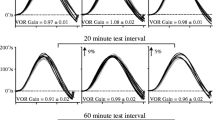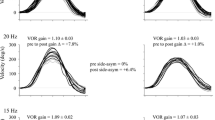Abstract
Clear vision of objects that move in depth toward or away from an observer requires vergence eye movements. The vergence system must interact with the vestibular system to maintain the object images on the foveae of both eyes during head movement. Previous studies have shown that training with sinusoidal vergence-vestibular interaction improves the frequency response of vergence eye movements during pitch rotation: vergence eye velocity gains increase and phase-lags decrease. To further understand the changes in eye movement responses in this adaptation, we examined latencies of vergence eye movements before and after vergence-vestibular training. Two head-stabilized Japanese monkeys were rewarded for tracking a target spot moving in depth that required vergence eye movements of 10°/s. This target motion was synchronized with pitch rotation at 20°/s. Both target and chair moved in a trapezoidal waveform interspersed with random inter-trial intervals. Before training, pitch rotation in complete darkness without a target did not induce vergence eye movements. Mean latencies of convergence and divergence eye movements induced by vergence target motion alone were 182 and 169 ms, respectively. After training, mean latencies of convergence and divergence eye movements to a target synchronized with pitch rotation shortened to 65 and 53 ms, and vergence eye velocity gains (relative to vergence target velocity) at the normal latencies were 0.68 and 1.53, respectively. Pitch rotation alone without a target induced vergence eye movements with similar latencies after training. These results indicate that vestibular information can be used effectively to initiate vergence eye movements following vergence-vestibular training.

Similar content being viewed by others
References
Collewijn H, Erkelens CJ (1991) Binocular eye movements and the perception of depth. In: Kowler E (ed) Eye movements and their role in visual and cognitive processes. Elsevier, Amsterdam, pp 213–261
Fuchs AF, Robinson DA (1966) A method for measuring horizontal and vertical eye movements chronically in the monkey. J Appl Physiol 21:1068–1070
Fukushima K (2003) Frontal cortical control of smooth-pursuit. Curr Opin Neurobiol 13:647–654
Fukushima K, Sato T, Fukushima J, Shinmei Y, Kaneko CRS (2000) Activity of smooth pursuit-related in the monkey periarcuate cortex during pursuit and passive whole body rotation. J Neurophysiol 83:563–587
Fukushima K, Wells SG, Yamanobe T, Takeichi N, Shinmei Y, Fukushima J (2001) Adaptive changes in smooth pursuit eye movements induced by cross-axis pursuit-vestibular interaction training in monkeys. Exp Brain Res 139:473–481
Fukushima K, Yamanobe T, Shinmei Y, Fukushima J, Kurkin S, Peterson BW (2002) Coding of smooth eye movements in three-dimensional space by frontal cortex. Nature 419:157–162
Gonzalez F, Perez R (1998) Neural mechanisms underlying stereoscopic vision. Prog Neurobiol 55:191–224
Ito M (1984) The cerebellum and neural control. Raven Press, New York
Leigh RJ, Zee DS (1999) The neurology of eye movements, 3rd edn. Oxford University Press, New York
Sato F, Akao T, Kurkin S, Fukushima J, Fukushima K (2004) Adaptive changes in vergence eye movements induced by vergence-vestibular interaction training in monkeys. Exp Brain Res 156:164–173
Walker MF, Zee DS (2002) Rectified cross-axis adaptation of the vestibulo-ocular reflex in rhesus monkey. Ann NY Acad Sci 956:543–545
Wilson VJ, Melvill Jones G (1979) Mammalian vestibular physiology. Plenum Press, New York
Acknowledgements
We thank Dr. Chris R.S. Kaneko for his valuable comments on this manuscript and Ms. Tsubura Yasuda for technical assistance. This work was supported by Japanese Ministry of Education, Culture, Science, Sports and Technology (12480244, 14017003, 14658266), Marna Cosmetics and Toyota Riken.
Author information
Authors and Affiliations
Corresponding author
Rights and permissions
About this article
Cite this article
Akao, T., Kurkin, S. & Fukushima, K. Latency of adaptive vergence eye movements induced by vergence-vestibular interaction training in monkeys. Exp Brain Res 158, 129–132 (2004). https://doi.org/10.1007/s00221-004-2002-2
Received:
Accepted:
Published:
Issue Date:
DOI: https://doi.org/10.1007/s00221-004-2002-2




